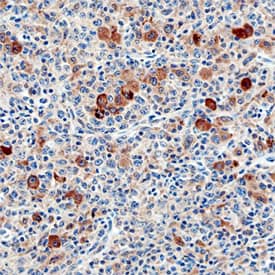Human Siglec-11 Antibody
R&D Systems, part of Bio-Techne | Catalog # MAB3258


Key Product Details
Species Reactivity
Validated:
Cited:
Applications
Validated:
Cited:
Label
Antibody Source
Product Specifications
Immunogen
PPARLSWTRWGQTVGPSQPSDPGVLELPPIC
Accession # Q96RL6
Specificity
Clonality
Host
Isotype
Scientific Data Images for Human Siglec-11 Antibody
Detection of Siglec‑11 in HEK293 Human Cell Line Transfected with Human Siglec-11 and eGFP by Flow Cytometry.
HEK293 human embryonic kidney cell line transfected with either (A) human Siglec-11 or (B) human Siglec-16 and eGFP was stained with Mouse Anti-Human Siglec-11 Monoclonal Antibody (Catalog # MAB3258) followed by Allophycocyanin-conjugated Anti-Mouse IgG Secondary Antibody (Catalog # F0101B) and . Quadrant markers were set based on control antibody staining (Catalog # MAB003). View our protocol for Staining Membrane-associated Proteins.Siglec‑11 in Human Lymph Node.
Siglec-11 was detected in immersion fixed paraffin-embedded sections of human lymph node using Mouse Anti-Human Siglec-11 Monoclonal Antibody (Catalog # MAB3258) at 5 µg/mL overnight at 4 °C. Before incubation with the primary antibody, tissue was subjected to heat-induced epitope retrieval using Antigen Retrieval Reagent-Basic (Catalog # CTS013). Tissue was stained using the Anti-Mouse HRP-DAB Cell & Tissue Staining Kit (brown; Catalog # CTS002) and counterstained with hematoxylin (blue). Specific staining was localized to cytoplasm. View our protocol for Chromogenic IHC Staining of Paraffin-embedded Tissue Sections.Applications for Human Siglec-11 Antibody
CyTOF-ready
Flow Cytometry
Sample: HEK293 human embryonic kidney cell line transfected with human Siglec-11
Immunohistochemistry
Sample: Immersion fixed paraffin-embedded sections of human lymph node
Formulation, Preparation, and Storage
Purification
Reconstitution
Formulation
Shipping
Stability & Storage
- 12 months from date of receipt, -20 to -70 °C as supplied.
- 1 month, 2 to 8 °C under sterile conditions after reconstitution.
- 6 months, -20 to -70 °C under sterile conditions after reconstitution.
Background: Siglec-11
Siglecs (sialic acid binding Ig-like lectins) are I-type lectins that belong to the immunoglobulin superfamily. They are characterized by an N‑terminal Ig-like V-set domain which mediates sialic acid binding, followed by a varying numbers of Ig-like C2-set domains. Siglecs‑3 and 5‑13 constitute the CD33/Siglec-3 related group, which are defined by their sequence homology and differential expression in the hematopoietic system (1‑3). Mature human Siglec-11 consists of a 534 amino acid (aa) extracellular domain (ECD), a 23 aa transmembrane segment, and a 114 aa cytoplasmic domain. The ECD contains one Ig-like V-set domain, and three Ig-like C2-set domains. The cytoplasmic domain contains two immunoreceptor tyrosine-based inhibitory motifs (ITIMs) (4). A splice variant of Siglec-11 has a deletion of nearly 100 aa in the extracellular juxtamembrane region. Among siglecs, the ECD of Siglec-11 is most closely related to that of Siglec-10 (82% aa sequence identity). The cytoplasmic domains of these proteins are only 20% identical. Siglec-11 is closely related to the pseudogenes Siglec-14 and Siglec-16 (4, 5). Human Siglec-11 shares 90%‑96% aa sequence identity with Siglec-11 from great apes. Rodent orthologs of Siglec-11 have not been identified. In human, Siglec-11 is expressed in tissue macrophages, brain microglia, and inflammatory site monocytes (4). Strong microglial expression is specific to humans, as it is less prominent or absent in chimpanzees and orangutans (5). Siglec-11 forms 180 kDa disulfide-linked dimers. It shows a strong binding preference for sialic acid in alpha2-8 linkage which is unusual for siglecs (4). A conserved arginine in the Ig-like V-set domain only partially contributes to Siglec-11 ligand recognition, in contrast to its being required in other siglecs (4). Tyrosine phosphorylation of the cytoplasmic region of Siglec-11 promotes association with the phosphatases SHP-1 and SHP-2 (4).
References
- Varki, A. and T. Angata (2006) Glycobiology 16:1R.
- Crocker, P.R. (2005) Curr. Opin. Pharmacol. 5:431.
- Crocker, P.R. (2002) Curr. Opin. Struct. Biol. 12:609.
- Angata, T. et al. (2002) J. Biol. Chem. 277:24466.
- Hayakawa, T. et al. (2005) Science 309:1693.
Long Name
Alternate Names
Entrez Gene IDs
Gene Symbol
UniProt
Additional Siglec-11 Products
Product Documents for Human Siglec-11 Antibody
Product Specific Notices for Human Siglec-11 Antibody
For research use only
